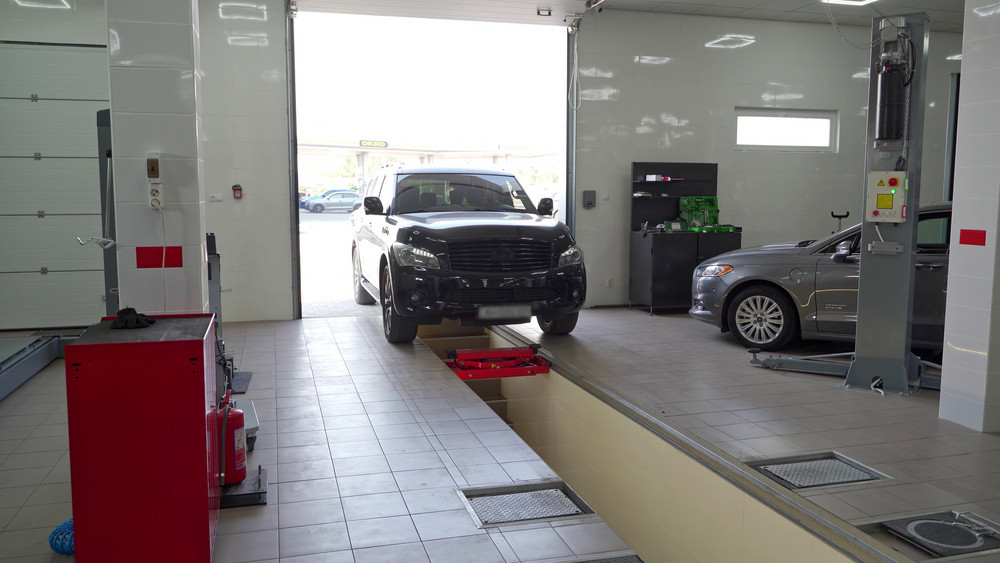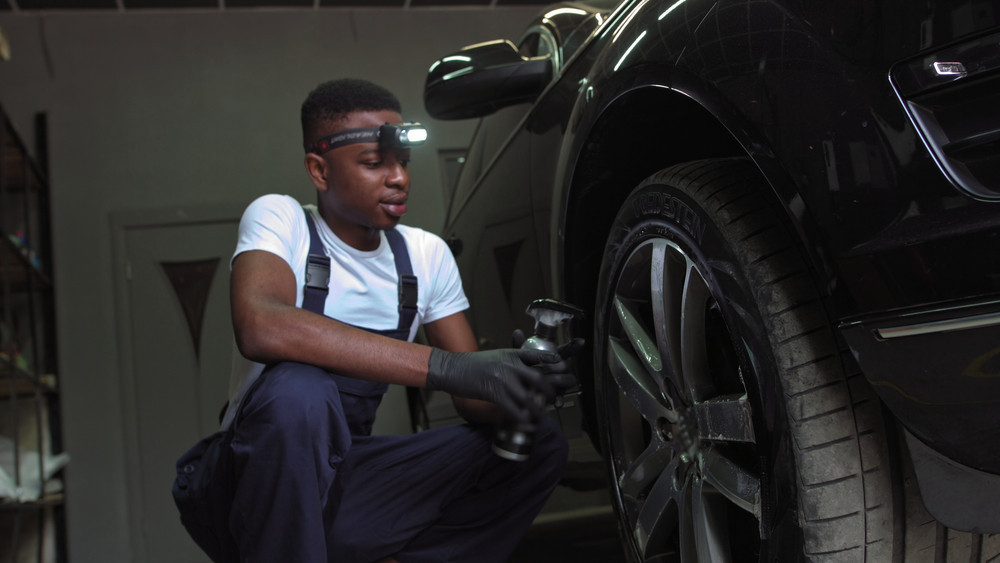Highlights
- Alignment adjusts wheel angles (camber, caster, toe) so tires meet the road correctly and the car tracks straight.
- Balancing corrects weight distribution around the tire–wheel assembly to prevent vibration at speed.
- Misalignment shows up as pulling, off-center steering wheels, and uneven tire wear; imbalance shows as shaking or vibration.
- You’ll typically balance with new tires or rotations and align after impacts, suspension work, or when symptoms appear.
- Keeping both in spec improves safety, comfort, fuel economy, and tire longevity while protecting suspension components.
Two Services, Two Purposes
Wheel alignment and wheel balancing are often mentioned together, but they solve different problems. Alignment is all about geometry—adjusting how each wheel points and tilts relative to the vehicle and road. Technicians set camber (inward or outward tilt), caster (steering pivot angle), and toe (inward or outward pointing) to manufacturer specifications so the vehicle tracks straight and tires wear evenly. Balancing, on the other hand, is about physics—ensuring the rotating tire–wheel assembly has even mass distribution. If a wheel has a heavy spot, it creates oscillations that you feel as vibration, most noticeably at highway speeds. Keeping both in check is essential to ride quality and safety.
How Wheel Alignment Works
During an alignment, a shop uses a computerized alignment rack with cameras or lasers and reflective targets on each wheel. The equipment measures current angles against factory specs. If readings are outside tolerance, the technician adjusts tie rods for toe, and where possible uses cam bolts, slotted struts, or eccentric bushings to bring camber and caster back into range. Even small deviations compound as speed rises, adding rolling resistance and causing feathered tread edges. According to AAA, alignment primarily influences directional stability and tire wear patterns, helping the car track straight with a centered steering wheel and predictable handling.
How Wheel Balancing Works
Balancing begins by mounting the wheel–tire assembly on a spin balancer. The machine detects where mass is uneven and prescribes counterweights. The technician then attaches small clip-on or adhesive weights to the rim to cancel heavy spots. Modern balancers can account for wheel width, diameter, and offset, and can suggest inside-only placements to preserve appearance. If a tire has developed flat spots from storage or internal belt irregularities, the balancer will still reduce vibration, though replacement may be wise in severe cases. The result of correct balancing is a smoother ride with less steering wheel, seat, or floorboard shake, especially noticeable between 50 and 70 mph.
Symptoms: Alignment vs. Balancing
Misalignment and imbalance feel different. Alignment problems commonly present as a vehicle pulling to one side on a level road, a steering wheel that sits off-center when driving straight, or tires that wear more on inner or outer shoulders. You might also hear mild squeal during turns as scrub builds across the tread. Imbalance, by contrast, shows up as speed-dependent vibration—often a light buzz in the steering wheel at specific speeds, progressing to a shimmy that may be felt in the seat or floor. Tires with “cupping” or scalloped wear often indicate prolonged imbalance or worn dampers.
When to Align, When to Balance
You’ll usually balance tires when installing new ones, after puncture repairs, or during periodic rotations. Many owners schedule balancing with each rotation interval because even a small weight loss can return vibration. Alignment, however, is typically done less frequently, such as annually, when you notice symptoms, or after events likely to disturb geometry—hitting potholes, sliding into a curb, or replacing suspension and steering parts. Some vehicles with adjustable rear suspensions benefit from four-wheel alignments so the rear “thrust line” is square to the body, ensuring the steering wheel centers naturally on straight roads.
What Each Service Protects
Proper alignment maximizes tire contact patches so braking, cornering, and tread wear are optimized. It also reduces rolling resistance, which can support fuel economy by minimizing scrub. Poor alignment accelerates shoulder wear, forcing premature tire replacement and potentially overworking stability control or lane keeping systems that compensate for drift. Proper balancing, meanwhile, protects rotating components from vibration fatigue. Chronic shake can accelerate wear in wheel bearings, tie rods, ball joints, and struts or shocks. Eliminating imbalance isn’t just about comfort; it reduces noise, protects parts, and preserves the refined feel modern suspensions are engineered to deliver.
DIY Checks vs. Professional Measurements
At home, you can spot clues but not substitute professional measurements. A straight yet off-center steering wheel, diagonal feathering, or asymmetric shoulder wear are classic alignment hints you’ll see during a pressure check or wash. A vibration that appears at one speed range and fades above or below it points to balance. You can try rotating front to rear; if steering wheel vibration migrates to the seat, the culprit wheel likely moved with the rotation. Still, precision corrections require alignment and balancing equipment—and a tech who can interpret readings and inspect for bent rims, worn bushings, or impact damage before dialing in final settings.
Tire Rotation, Safety, and Service Intervals
Rotation is the maintenance bridge between alignment and balancing because it equalizes wear and often triggers a balance check. According to NHTSA TireWise, rotating tires at intervals recommended by your vehicle manufacturer—commonly every 5,000 to 8,000 miles—helps reduce irregular wear and prolong tire life. Rotations are also an ideal moment to inspect tread depth, look for cupping, and rebalance assemblies as needed. If uneven wear is already visible before a scheduled rotation, it’s wise to inspect alignment early rather than waiting for the next mileage milestone.
Modern Vehicles and Advanced Systems
Late-model vehicles with driver-assist features rely on predictable tire contact and stable geometry. Misalignment can create steering angle sensor offsets and subtle drift that camera or radar systems must correct. After collision repairs or suspension work, many shops perform alignment alongside calibrations for advanced driver assistance systems (ADAS) to ensure lane centering and emergency steering aids behave as designed. Likewise, modern low-profile tires mounted on large, light-alloy wheels are more sensitive to imbalance; even a few grams at the rim can translate to noticeable shake at speed. Balancing precision matters more than ever as wheel diameters grow.
Costs, Time, and Expectations
Balancing typically takes a few minutes per wheel once the tire is mounted and the balancer is configured, whereas a thorough four-wheel alignment can take significantly longer, especially if adjustments are seized or shims are required. Expect a test drive before and after alignment to confirm a centered wheel and straight tracking. For balancing, ask your shop whether they use static, dynamic, or road-force methods; dynamic balancing addresses both vertical and lateral forces, while road-force equipment can diagnose tire uniformity issues that standard spin balancing might miss. Quality service also includes rechecking after a short drive if a vibration persists.
Putting It All Together
Think of alignment and balancing as complementary. Alignment sets the direction and angle of travel so each tire shares the workload correctly; balancing ensures the assembly spins smoothly at speed. If you’re installing new tires, request both services and a printout of alignment measurements. If you’re chasing a vibration, start with balancing and an inspection for bent wheels or out-of-round tires; if the wheel is straight and still shakes, investigate suspension wear. Addressing both sides of the equation yields a car that steers accurately, rides quietly, uses less fuel, and makes the most of every millimeter of tread.





